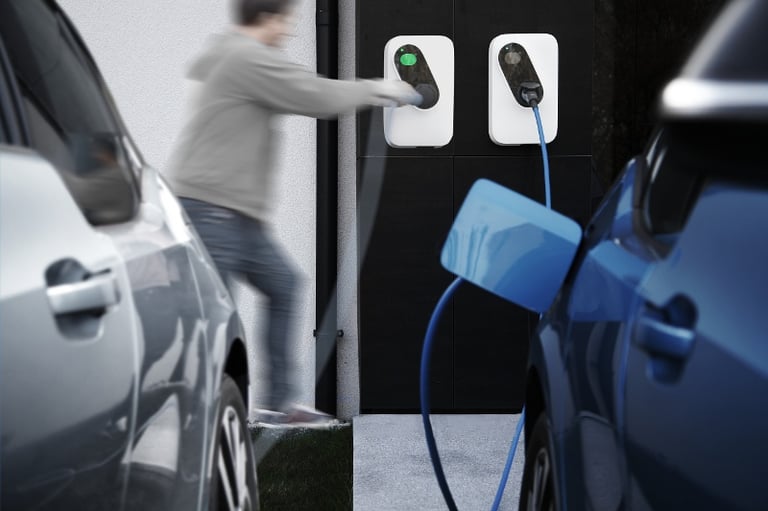 Electric vehicles (EVs) are seeing tremendous adoption globally and will play a significant role in a distributed energy system and in the transition to a net zero society. Recognizing that EVs represent both challenges and opportunities for utilities, Landis+Gyr acquired two companies in the EV charging space: Etrel and True Energy. With these acquisitions, we expand our offering to utilities through EV charging hardware and smart charging software, including demand response and flexibility management to better manage the grid.
Electric vehicles (EVs) are seeing tremendous adoption globally and will play a significant role in a distributed energy system and in the transition to a net zero society. Recognizing that EVs represent both challenges and opportunities for utilities, Landis+Gyr acquired two companies in the EV charging space: Etrel and True Energy. With these acquisitions, we expand our offering to utilities through EV charging hardware and smart charging software, including demand response and flexibility management to better manage the grid.
We caught up with Miha Levstek, CEO of Etrel and talked about the developments in the e-mobility market, challenges and opportunities in the energy sector and how Landis+Gyr, Etrel and True Energy can help utilities to master them.
Etrel
Since 2007 Etrel has been designing and developing innovative charging solutions that help transform EVs from static consumers to essential building blocks of smart grid infrastructure. Etrel product portfolio provides stable and scalable solutions to any charge point operator and e-mobility service provider who wants to help EVs become an integral part of the energy infrastructure and facilitate the integration of renewably sourced energy for electric mobility.

Miha Levstek, CEO of Etrel and Head of Business Unit EV Charging Solutions at Landis+Gyr
Etrel was acquired by Landis+Gyr last Summer. What is the background of the acquisition? What does it mean for Etrel and Landis+Gyr?
Miha: In recent years, as e-mobility picked up the pace, Etrel experienced exponential growth. We have been looking for a strategic partner to help us plan the company's processes and structure to increase the rollout of our INCH charging stations worldwide while ensuring the product and service quality we strive for.
Landis+Gyr is a great match with more than 125 years of manufacturing tradition, known for its product quality and a strong emphasis on long-standing customer relationships and sustainability, which we highly value at Etrel.
With the acquisition of Etrel, a supplier of interactive EV charging stations and charge point management software and True Energy, a provider of demand response solutions for consumers and flexibility management for utilities, Landis+Gyr continues to strengthen its is comprehensive solutions portfolio for the energy sector, from metering and smart infrastructure management to interactive EV charging and flexibility services.
Leading the e-mobility division inside Landis+Gyr, Etrel will be able to realize its full potential and, together with Landis+Gyr and True Energy, shape the future mobility trends.
What is your view on the current status of e-mobility and especially EV charging?
Miha: Reaching a trajectory consistent with the IEA (International Energy Agengy) Sustainable Development Scenario will require putting globally 230 million EVs on the roads by 2030. 2020 is for sure a tipping-point year for EV sales. Nevertheless, car manufacturers and consumers need to accelerate the EV adoption to limit the impact of transportation on climate change. The success of this transition to zero-emission vehicles still heavily relies on the deployment of supporting infrastructure and services.
Publicly accessible chargers reached 1.3 million units globally in 2020. China leads the world in the availability of public chargers, representing more than half of the world's chargers. Europe is second, with installations increasing by 30% in 2020. Despite solid growth, especially in northern regions, e-mobility is developing at significantly different speeds across Europe. The expected update of the EU Alternative Fuels Infrastructure Regulation will set the course for the development of e-mobility across the EU for the next decade. While not all proposed changes may be ideal, the regulation notably presses forward with smart and connected charging, demanding increased accessibility and information and more clarity on the connection and influence of the power sector role and services.
Which challenges & opportunities do you see for the energy sector and utilities related to e-mobility?
Miha: Utilities should assume a significant role in accelerating broader e-mobility infrastructure rollout. They are in a unique position of having millions of customers on hand, who will transition from traditional internal combustion engine, short ICE, to EVs. As the majority of charging will happen at home, there is an expected additional strain on the grid during the peak hours when most of the vehicles will be connected simultaneously.
While investing in grid infrastructure will be necessary to increase capacity and ensure stable operation, the scope of increase can be reduced by considering EVs as dynamic loads that can be managed timely. Therefore, the primary role for utilities lies in developing smart grid infrastructure, incentivizing the use of smart and connected charging devices and planning IT infrastructure in a way that will enable large-scale participation of end customers in energy markets, allowing demand response services.
Current grid usage fees, which are based on installed or maximum power, significantly burden the operation cost due to the low peak-to-average power ratio. Utilities will need to act as enablers for developing EV charging infrastructure by adopting different tariff schemes emphasising grid usage fees to ease market entry for new charge point operators and enable existing ones to scale their business faster.
How can Etrel and Landis+Gyr support solving these challenges and materialize these opportunities?
Miha: E-mobility currently faces three significant challenges: the availability of electric cars, charging infrastructure, and load management options. Of course, we are not trying to solve the first problem, but we are developing solutions for the second two.
Our recently expanded production facilities allowed us to quadruple production capacity. By accelerating order fulfillment and consequently field deployment we help our partners grow smart charging infrastructure faster in respective markets.
The load management challenge is being directly addressed by our technology - Interactive Charging. The ultimate goal is to avoid grid overloads and to ensure the safety and quality of the power supply. Both the INCH charging stations and the OCEAN charge point and energy management system provide comprehensive load management functionalities. In addition, Interactive Charging technology also reinforces the use of renewably sourced energy to power EVs, which is crucial for the future of e-mobility.
With the combination of its existing energy management portfolio with Etrel’s load management capabilities and True energy’s flexibility services app for end users, which expands flexibility even outside the realm of EV charging, Landis+Gyr brings together a complete solution portfolio for the energy sector.
What differentiates Etrel from other companies in the EV charging space?
Miha: We believe electric vehicles can provide a long-term solution to the problems of air pollution, climate change and energy efficiency - as long as they are powered by sustainably generated energy. We want to build a legacy in decarbonizing personal transportation - that's why we have built our products on the base of interactive charging principles.
Etrel Interactive Charging technology balances the charging demands of users, vehicle and other chargers installed in the same location with building power supply limitations, local energy production and grid demand. A set of load management rules, combined with live data and preset thresholds, influence the charging schedule ensuring vehicles are ready when they are needed, without the risk of broken fuse or overloading of the local grid.
Our integrated portfolio of INCH charging stations and OCEAN charge point and energy management system thus provides a unique offering in terms of combined functionalities and immediate business implications. It is designed to manage and control energy use in electric vehicle charging across the entire e-mobility ecosystem to ensure EVs become an essential part of smart grids, providing the needed flexibility for mass integration of renewable energy sources.




